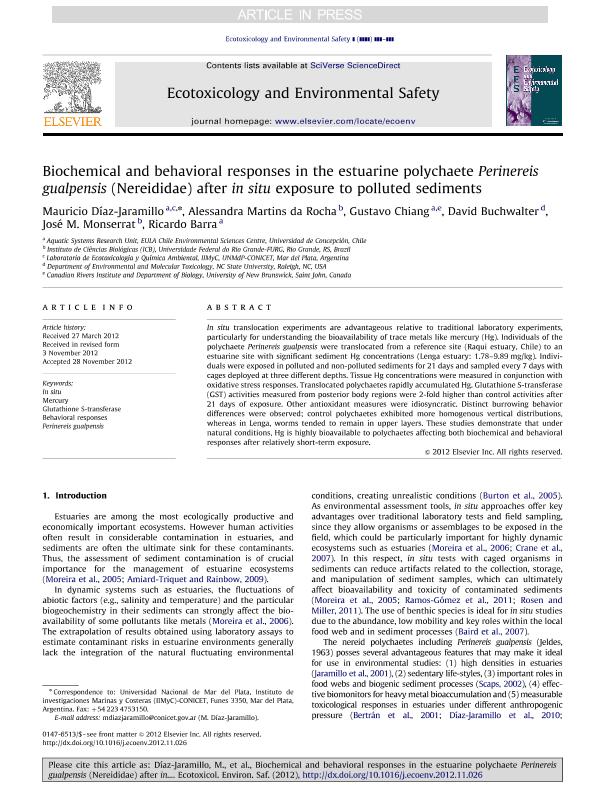Mostrar el registro sencillo del ítem
dc.contributor.author
Diaz Jaramillo, Mauricio Javier

dc.contributor.author
da Rocha, Alessandra Martins
dc.contributor.author
Chiang, Gustavo
dc.contributor.author
Buchwalter, David
dc.contributor.author
Monserrat, José María

dc.contributor.author
Barra, Ricardo
dc.date.available
2020-01-29T14:00:19Z
dc.date.issued
2013-03
dc.identifier.citation
Diaz Jaramillo, Mauricio Javier; da Rocha, Alessandra Martins; Chiang, Gustavo; Buchwalter, David; Monserrat, José María; et al.; Biochemical and behavioral responses in the estuarine polychaete Perinereis gualpensis (Nereididae) after in situ exposure to polluted sediments; Academic Press Inc Elsevier Science; Ecotoxicology and Environmental Safety; 89; 3-2013; 182-188
dc.identifier.issn
0147-6513
dc.identifier.uri
http://hdl.handle.net/11336/96086
dc.description.abstract
In situ translocation experiments are advantageous relative to traditional laboratory experiments, particularly for understanding the bioavailability of trace metals like mercury (Hg). Individuals of the polychaete Perinereis gualpensis were translocated from a reference site (Raqui estuary, Chile) to an estuarine site with significant sediment Hg concentrations (Lenga estuary: 1.78–9.89 mg/kg). Individuals were exposed in polluted and non-polluted sediments for 21 days and sampled every 7 days with cages deployed at three different depths. Tissue Hg concentrations were measured in conjunction with oxidative stress responses. Translocated polychaetes rapidly accumulated Hg. Glutathione S-transferase (GST) activities measured from posterior body regions were 2-fold higher than control activities after 21 days of exposure. Other antioxidant measures were idiosyncratic. Distinct burrowing behavior differences were observed; control polychaetes exhibited more homogenous vertical distributions, whereas in Lenga, worms tended to remain in upper layers. These studies demonstrate that under natural conditions, Hg is highly bioavailable to polychaetes affecting both biochemical and behavioral responses after relatively short-term exposure.
dc.format
application/pdf
dc.language.iso
eng
dc.publisher
Academic Press Inc Elsevier Science

dc.rights
info:eu-repo/semantics/openAccess
dc.rights.uri
https://creativecommons.org/licenses/by-nc-nd/2.5/ar/
dc.subject
IN SITU
dc.subject
MERCURY
dc.subject
GST
dc.subject
BEHAVIORAL RESPONSES
dc.subject
PERINEREIS GUALPENSIS
dc.subject.classification
Otras Ciencias de la Tierra y relacionadas con el Medio Ambiente

dc.subject.classification
Ciencias de la Tierra y relacionadas con el Medio Ambiente

dc.subject.classification
CIENCIAS NATURALES Y EXACTAS

dc.title
Biochemical and behavioral responses in the estuarine polychaete Perinereis gualpensis (Nereididae) after in situ exposure to polluted sediments
dc.type
info:eu-repo/semantics/article
dc.type
info:ar-repo/semantics/artículo
dc.type
info:eu-repo/semantics/publishedVersion
dc.date.updated
2020-01-28T14:58:04Z
dc.journal.volume
89
dc.journal.pagination
182-188
dc.journal.pais
Países Bajos

dc.journal.ciudad
Amsterdam
dc.description.fil
Fil: Diaz Jaramillo, Mauricio Javier. Consejo Nacional de Investigaciones Científicas y Técnicas; Argentina. Universidad de Concepción; Chile
dc.description.fil
Fil: da Rocha, Alessandra Martins. Universidade Federal do Rio Grande do Sul; Brasil
dc.description.fil
Fil: Chiang, Gustavo. Universidad de Concepción; Chile. University Of New Brunswick; Canadá
dc.description.fil
Fil: Buchwalter, David. University of North Carolina; Estados Unidos
dc.description.fil
Fil: Monserrat, José María. Universidade Federal do Rio Grande do Sul; Brasil
dc.description.fil
Fil: Barra, Ricardo. Universidad de Concepción; Chile
dc.journal.title
Ecotoxicology and Environmental Safety

dc.relation.alternativeid
info:eu-repo/semantics/altIdentifier/url/https://www.sciencedirect.com/science/article/pii/S0147651312004460
dc.relation.alternativeid
info:eu-repo/semantics/altIdentifier/doi/http://dx.doi.org/10.1016/j.ecoenv.2012.11.026
Archivos asociados
